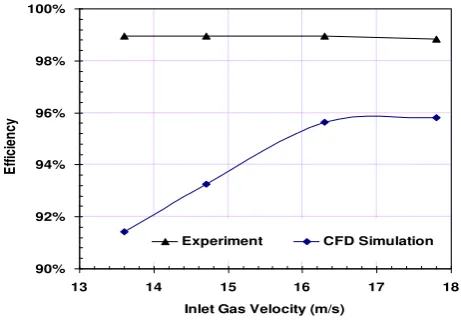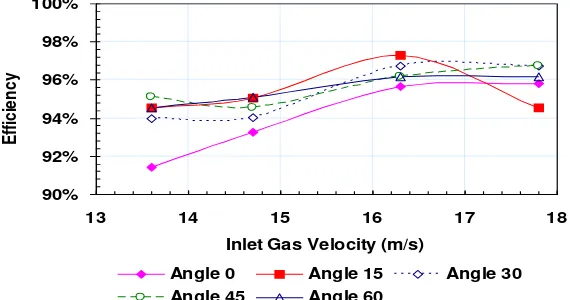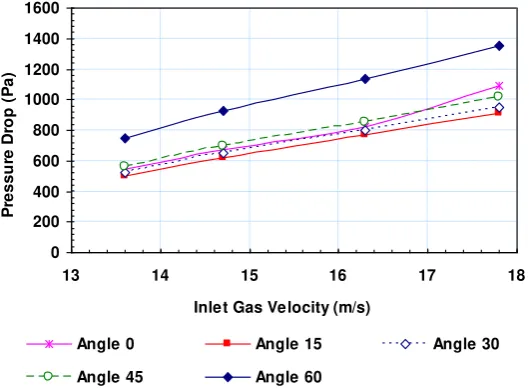The Comparison of Cyclone Performance for Different Inlet Gas Angle
Novi Caroko
1*), Suyitno
2)1
Jurusan Teknik Mesin, Fakultas Teknik, Universitas Muhammadiyah Yogyakarta
2
Jurusan Teknik Mesin, Fakultas Teknik, Universitas Negeri Sebelas Maret Surakarta
Email: [email protected]*)
Abstract
This research goals to obtain cyclone engine designs that have high performance. Particle separation efficiency and pressure loss are two important parameters on cyclone performance. The cyclone that has a high efficiency with very low pressure loss required to reduce operating costs. The research was conducted by using CFD simulation (computational fluid dynamic). The cyclone has diameter 30 cm. Reynolds stress model (RSM) is used as a model in the turbulent CFD simulation. The inlet gas angle is varied from 0o, 15o, 30o, 45o, and 60o. For each inlet gas angle, the inlet gas velocity is varied by 13.6 m/s, 14.7 m/s, 16.3 m/s, and 17.8 m/s. During the CFD simulations, the particles were calculated using Euler-Lagrangian method. From this research can be concluded that the particle separation efficiency is higher than 90% for all inlet gas velocity variation. It is noted that the pressure drop is increasing linearly with velocity. The lowest pressure drop is found at inlet gas angle of 15o. For lower operating cost, the utilization of the inlet gas velocity 13.6 m/s and the inlet gas angle 15o is preferred.
Wood gasification becomes more important recently because of . i
Keywords : Cyclone, inlet gas angle, inlet gas velocity, CFD, and Reynolds Stress Turbulen RSM
Abstrak
Penelitian ini bertujuan untuk mendapatkan desain mesin siklon yang memiliki performa tinggi. Efisiensi pemisahan partikel dan kehilangan tekanan adalah dua parameter penting pada kinerja mesin siklon. Mesin siklon yang memiliki efisiensi tinggi dengan kehilangan tekanan yang sangat rendah diperlukan untuk mengurangi biaya operasi. Penelitian dilakukan dengan menggunakan simulasi CFD (computational fluid dynamic). Mesin siklon ini memiliki diameter 30 cm. Reynolds Model Stres (RSM) digunakan sebagai model di simulasi CFD turbulen. Sudut gas masuk bervariasi dari 0o, 15o, 30o, 45o, dan 60o. Untuk setiap sudut gas inlet, kecepatan gas inlet bervariasi sebesar 13,6 m / s, 14,7 m / s, 16,3 m / s, dan 17,8 m / s. Selama simulasi CFD, partikel dihitung dengan menggunakan metode Euler-Lagrangian. Dari penelitian ini dapat disimpulkan bahwa efisiensi pemisahan partikel lebih tinggi dari 90% untuk semua variasi kecepatan gas masuk. Perlu dicatat bahwa penurunan tekanan meningkat secara linear berbanding dengan kecepatan. Penurunan tekanan terendah ditemukan di sudut gas inlet 15o. Untuk biaya operasional yang lebih rendah dapat menggunakan kecepatan gas masuk 13,6 m / s dan sudut inlet 15o .
1.
Introduction
Cyclones due to its characteristics are often used as separation equipments for particles and gases. The utilization of cyclones is often found as an air pollution control tools from particle polluter. Cyclones can also be found in the combustion process for solid fuel (pulverized) feeding in the boiler.
There are two keys performance of cyclone, i.e. the particle separation efficiency and the pressure drop. The cyclone with high efficiency and low pressure drop is desired. In order to find out the cyclone design with high performance, the cyclone research is carried out numerically using CFD simulation.
2.
Literature Study
Many researchers investigated cyclone performance (Funk, P.A. et al., 2000, Mukherjee, et al., 2003, Peng, et al., 2005, Bernardo et al., 2005). The modification of cyclone body diameter and outlet gas pipe diameter do not influence significantly on the efficiency. Whereas, according to Funk, P.A. et al., 2000, the efficiency is slightly increasing and the pressure drop is also increasing with modification of the cyclone geometry and inlet gas velocity.
Another investigator found that as inlet gas pressure increases, the gas flow inside cyclone is also increasing and consequently the pressure drop is higher (Mukherjee, et al., 2003). The free vortex that is built from increasing gas pressure will affect the increasing axial velocity of particles. By increasing inlet gas pressure from 5.2 to 6.4 psi is able to increase the gas flow 15% and to increase efficiency 0.6%. The inlet gas angle of 45o has also been investigated numerically (Bernardo et al., 2005). They found that there was increasing tangential velocity inside cyclone without increasing pressure drop with increasing inlet gas angle of 45o.
Cyclone with smaller cone has higher efficiency. This finding showed that the particles are accelerated in the cone section due to decreasing gradually of cone area. Smaller cone area results in higher tangential and centrifugal velocity of the particles. It is important to note that the modification of cone diameter does not change the shape of efficiency curve (Xiang et al., 2001, Xiang et al., 2005).
Gas inside the cyclone will circulate in all direction. Gas flow in cyclone can be categorized as turbulent flow. Turbulent flow is the flow that fluctuating with time and space. Turbulent flow is a complex process. Turbulent flow is happen when inertia force in the gas flow is dominant than viscous force and usually can be characterized by high Reynolds number. The calculation in CFD simulation for turbulent flow is different from laminar flow
with including the Reynolds stress ( ) in the standard Navier Stokes equation. The Navier Stokes equation for turbulent flow is expressed as (Rodi, W., 1980, Hanjalic, K., 2005)
(1)
In the CFD simulation, many turbulence models have been proposed due to direct numerical simulation (DNS) is very tough for current computer performance. Two equations turbulence model that very familiar are model and Reynolds stress model (RSM). Standard is valid for very high Re number and therefore the turbulent
kinetic energy is assumed isotropic. In RSM, the Reynolds stress ( ) is calculated in all direction (see Equation (2) and therefore the calculation is more intensive than standard model.
' ' j iu u
' ' j i j i j i j j i iu
u
x
u
x
x
p
x
u
u
t
u
k k ' ' j iu u k
k i k j k j k i j i k k j ix
u
u
u
x
u
u
u
u
u
x
u
u
u
t
where Pij is the production rate of normal stress by mean shear. Dij is the diffusion rate of normal stress. This term
consists of turbulent fluctuation (t), pressure fluctuation (p) and molecular diffusion ( ). is the energy redistribution between the fluctuating velocity components. is the dissipation rate due to viscous action.
The turbulent kinetic energy (k) and turbulent dissipation rate ( ) can be calculated by Equation (3) and (4), respectively.
(3)
(4)
where
(5)
The turbulent viscosity is expressed as
(6)
3.
Methods
The research method for improving the performance of cyclone is carried out numerically via CFD simulation (FLUENT). The particles are treated by Euler Lagrangian method (Fluent, 2005). The turbulence model being used is Reynolds stress model (RSM). The discretization method being used is implicit order one. Segregated solver is used together with Gauss Seidel iteration method. The boundary conditions for the ratio of turbulent kinetic energy and of dissipation rate at inlet and two outlets are 10%. The dimension of cyclone is shown in Figure 1. The cyclone has diameter 30 cm. The sieve test of the particle being used in the simulation is represented in Table 1.
There are two important parameters that are investigated in this research, i.e. inlet gas velocity and inlet gas angle. The inlet gas angle is varied from 0o, 15o, 30o, 45o, and 60o. For each inlet gas angle, the inlet gas velocity is varied by 13.6 m/s, 14.7 m/s, 16.3 m/s, and 17.8 m/s.
[image:3.595.65.525.146.375.2]
Table 1. The sieve test of the particles (Funk, P.A, et al., 2000).
Sieve Size (µm) Mass Fraction (%)
12 > 1679 1.3
100 > 149 56.4
140 > 106 5.5
200 > 75 5.2
270 > 53 6.4
400 > 37 5.7
< 37 19.4
ij ij
ility compressib 2 2 1 2 1 t ii ii j k t j i i M G P x k x ku x kt
k C k G C P C x x u xt j ii ii
t j i i 2 2 3 1 2
1
0 , 1 C11,44C21,92
u
v
C
3
tanh
2 [image:3.595.67.299.563.659.2]Figure 1. The dimension of cyclone being investigated (D = 30 cm) (Funk, P.A, et al., 2000).
4.
Result and Discussion
4.1 Influence of the Inlet Gas Velocity
The advantage of RSM is that the anisotropic of turbulent kinetic energy and dissipation rate are calculated. There is slightly increasing of particle separation efficiency due to increasing velocity from 13.6 m/s to 17.8 m/s as shown in Figure 2. The particle separation efficiency from CFD simulation is lower than experiment but still higher than 90%. Figure 3 shows the particle tracking and the pressure drop in cyclone when the CFD simulation is performed at inlet gas velocity 13.6 m/s and inlet gas angle 0o. The sharp pressure drop is happen just after inlet gas position.
Figure 2. The particle separation efficiency vs. inlet gas velocity.
The utilization of RSM as turbulence model in cyclone simulation results in increasing the pressure drop with inlet gas velocity. The pressure drop increases linearly with inlet gas velocity as shown in Figure 4. The pressure drop obtained from CFD simulation fits well to the pressure drop obtained from experiment. The difference of those
90% 92% 94% 96% 98% 100%
13 14 15 16 17 18
Inlet Gas Velocity (m/s)
E
ff
ic
ie
n
cy
c
(a) The particle tracking (b) The pressure drop (Pa)
Figure 4. The pressure drop vs. inlet gas velocity.
4.2 Influence of the Inlet Gas Angle
The inlet gas angle has influence on the particle separation efficiency and the pressure drop as well. Figure 5 shows the changing of the particle separation efficiency due to the inlet gas angle for different inlet gas velocity. Although the trend is disorder, the particle separation efficiency is still higher than 90% for all different inlet gas angles.
Figure 6 shows the changing of the pressure drop due to the inlet gas angle for different inlet gas velocity. The pressure drop is increasing linearly with the inlet gas velocity for all different inlet gas angles. The lowest pressure drop is obtained when the inlet gas angle is 15o. With changing the inlet gas angle from 0o into 15o, the pressure drop is decreasing 7% as shown in Table 2.
It is worth noting that the pressure drop correlates directly to the operating cost of cyclone. The lower the pressure drop, the lower is the operating cost. By considering this fact, the utilization of lower inlet gas velocity is preferred. Since the particle separation efficiency is only decreasing slightly whereas the pressure drop is decreasing significantly with lower inlet gas velocity, therefore the utilization of the inlet gas velocity as much 13.6 m/s and the inlet gas angle 15o is more advantage. The particle separation efficiency then can be further increased by using two level of cyclone.
[image:6.595.158.443.483.633.2]
Figure 5. The particles separation efficiency vs. inlet gas velocity for different inlet gas angle.
0 200 400 600 800 1000 1200
13 14 15 16 17 18
Inlet Gas Velocity (m/s)
P
re
s
s
u
re
D
ro
p
(
P
a
)
c
Experiment CFD Simulation
90% 92% 94% 96% 98% 100%
13 14 15 16 17 18
Inlet Gas Velocity (m/s)
E
ff
ic
ie
n
cy
c
Angle 0 Angle 15 Angle 30
Figure 6. The pressure drop vs. inlet gas velocity for different inlet gas angle.
Table 2. The pressure drop that is obtained from experimental data at inlet gas angle 0o and from CFD simulation at different inlet gas angle.
Inlet Gas Angle
0o 15o 30o 45o 60o
The Pressure Drop - Decreasing 7%
Decreasing 3.4%
Increasing 3.1%
Increasing 37.4%
5.
Conclusions
From this research can be concluded that the particle separation efficiency is higher than 90% for all inlet gas velocity variation. It is noted that the pressure drop is increasing linearly with velocity. The lowest pressure drop is found at inlet gas angle of 15o. Finally, for lower operating cost, the utilization of the inlet gas velocity 13.6 m/s and the inlet gas angle 15o is preferred.
For recommendations, this research can be continued experimentally for different cyclone geometry and particle distribution. Other turbulence models such as the Spalart-Allmaras model, the family of k model, and LES model can also be further investigated.
Acknowledgements
The authors would like to thank the DGHE, the Republic of Indonesia for the funding of this research by Young Lecture Research Grant with contract number: 32/H34.21/KTR.PT/2007.
Literature Cited
[1.] Bernardo, S., Peres, A.P, Mori, M., 2005, Computational Study of Ciclone Flow Fluid Dynamics Using a Different Inlet Section Angle, Thermal Engineering, Vol. 4 No. 1. June 2005, p. 18-23.
[2.] Fluent, I., 2005, Fluent User Guide. In: Lebanon.
[3.] Funk, P.A., Ed Hughs, S. , Holt, G.A., 2000, Entrance Velocity Optimization for Modified Dust Cyclones, The Journal of Cotton Science 4: 178-182 (2000).
[4.] Hanjalic, K., 2005, Turbulence and Transport Phenomena. Modelling and Simulation. TU Darmstadt, German.
[5.] Mukherjee, A.K., Sripriya, R., Rao, P.T., Das, P., 2003, Effect of Increase in Feed Inlet Pressure on Feed Rate of Dense Media Cyclone, Int.J.Miner.Process.69(2003) p.259– 274.
[6.] Peng. W., Hoffmann, A.C., Dries, H.W.A., Regelink, M.A., and Stein, L.E, 2005, Experimental Study of the Vortex End in Centrifugal Separators: The Nature of the Vortex End, Chemical Engineering Science 60 (2005) p.6919 – 6928.
0 200 400 600 800 1000 1200 1400 1600
13 14 15 16 17 18
Inlet Gas Velocity (m/s)
P
re
s
s
u
re
D
ro
p
(
P
a
)
c
Angle 0 Angle 15 Angle 30
[7.] Rodi, W., 1980, Turbulence Models and Their Application in Hydraulics - a State of the Art Review, German, Institut für Hydromechanik and Sonderforschungsbereich 80, University of Karlsruhe.
[8.] Xiang, R., Park, S.H, and Lee, K.W., 2001, Effects of Cone Dimension on Cyclone Performance, Aerosol Science 32 (2001) p.549-561.



